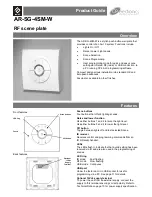Figure 15. De-registration failed
To retry, press and release the SW2 button again.
If you have trouble successfully de-registering a face, adjust the proximity to the camera (either closer or further
away) and slowly move your head left-right and up-down so that the camera can get a better view of different angles
of your face. For more information, see
.
NOTE
4.3 Liveness detection
The 3D Smart Lock application preprogrammed in the SLN-VIZN3D-IOT kit comes with the liveness detection activated by default
to make the most of the security features of the 3D camera. This solution can discern between an actual face and a printout,
phone display picture, or 3D cast-mold of a face. This level of protection is crucial in applications that require security to prevent
“face-spoofing” attacks.
As shown in the screenshot below, attempting to display a fake face to the camera results in a “Fake Face” UI message and
audio prompt.
Figure 16. Printed picture (2D) and mask (3D) spoof attacks
By requiring a user’s actual face to unlock the system (as opposed to a simple picture of the user’s face), this feature helps to
protect you from some of the most common face-recognition “spoof” attacks, where a malicious actor uses a picture of someone
to gain access to their face-protected materials.
Using the combination of an IR camera and a 3D camera, outdoor environments with high and low lighting conditions do not impact
the performance of the face-recognition algorithm.
NXP Semiconductors
Local face management
SLN-VIZN3D-IOT Kit User Guide, Rev. 0, 01 November 2021
User Guide
14 / 47


















